2002 NISSAN MAXIMA coolant temperature
[x] Cancel search: coolant temperaturePage 179 of 247

Parking brake*:Check that the lever has the
proper travel and make sure that the vehicle is
held securely on a fairly steep hill when only
the parking brake is applied.
Automatic transaxle P (Park) position
mechanism:On a fairly steep hill check that
the vehicle is held securely with the selector
lever in the P (Park) position without applying
any brakes.Under the hood and the vehicleThe maintenance items listed here should be
checked periodically (for example, each time
you check the engine oil or refuel).
Windshield washer fluid*:Check that there
is adequate fluid in the tank.
Engine coolant level*:Check the coolant
level when the engine is cold.
Radiator and hoses:Check the front of the
radiator and clean off any dirt, insects, leaves,
etc., that may have accumulated. Make sure
the hoses have no cracks, deformation, dete-
rioration or loose connections.
Brake and clutch fluid levels*:Make sure
that the brake and clutch fluid levels are be-
tween the MAX and MIN lines on the reservoir.
Battery*:Check the fluid level in each cell. It
should be between the MAX and MIN lines.Vehicles operated in high temperatures or
under severe conditions require frequent
checks of the battery fluid level.
Engine drive belts*:Make sure that no belt is
frayed, worn, cracked or oily.
Engine oil level*:Check the level on the
dipstick after parking the vehicle on a level
spot and turning off the engine.
Power steering fluid level* and lines:Check
the level in the reservoir tank with the engine
off. Check the lines for proper attachment,
leaks, cracks, etc.
Automatic transaxle fluid level*:Check the
level on the dipstick after putting the selector
lever in P (Park) position with the engine idling.
Exhaust system:Make sure there are no
loose supports, cracks or holes. If the sound of
the exhaust seems unusual or there is a smell
of exhaust fumes, immediately locate the
trouble and correct it. (See ªPrecautions when
starting and drivingº in the ª5. Starting and
drivingº section for exhaust gas (carbon mon-
oxide).)
Underbody:The underbody is frequently ex-
posed to corrosive substances such as those
used on icy roads or to control dust. It is very
important to remove these substances, other-
wise rust will form on the floor pan, frame, fuellines and around the exhaust system. At the
end of winter, the underbody should be thor-
oughly flushed with plain water, being careful
to clean those areas where mud and dirt may
accumulate. For additional information, see
ªCleaning exteriorº in the ª7. Appearance and
careº section.
Fluid leaks:Check under the vehicle for fuel,
oil, water or other fluid leaks after the vehicle
has been parked for a while. Water dripping
from the air conditioner after use is normal. If
you should notice any leaks or if gasoline
fumes are evident, check for the cause and
have it corrected immediately.8-4
Maintenance and do-it-yourself
Z
01.9.21/A33-D/V5.0
X
Page 183 of 247
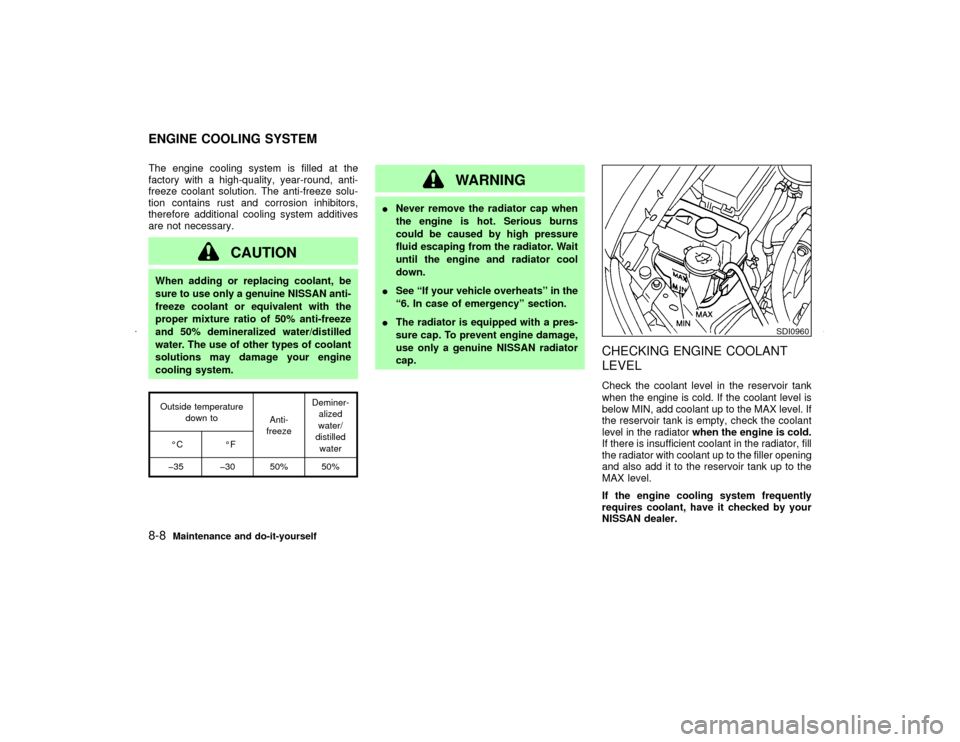
The engine cooling system is filled at the
factory with a high-quality, year-round, anti-
freeze coolant solution. The anti-freeze solu-
tion contains rust and corrosion inhibitors,
therefore additional cooling system additives
are not necessary.
CAUTION
When adding or replacing coolant, be
sure to use only a genuine NISSAN anti-
freeze coolant or equivalent with the
proper mixture ratio of 50% anti-freeze
and 50% demineralized water/distilled
water. The use of other types of coolant
solutions may damage your engine
cooling system.Outside temperature
down to
Anti-
freezeDeminer-
alized
water/
distilled
water ÉC ÉF
þ35 þ30 50% 50%
WARNING
INever remove the radiator cap when
the engine is hot. Serious burns
could be caused by high pressure
fluid escaping from the radiator. Wait
until the engine and radiator cool
down.
ISee ªIf your vehicle overheatsº in the
ª6. In case of emergencyº section.
IThe radiator is equipped with a pres-
sure cap. To prevent engine damage,
use only a genuine NISSAN radiator
cap.
CHECKING ENGINE COOLANT
LEVELCheck the coolant level in the reservoir tank
when the engine is cold. If the coolant level is
below MIN, add coolant up to the MAX level. If
the reservoir tank is empty, check the coolant
level in the radiatorwhen the engine is cold.
If there is insufficient coolant in the radiator, fill
the radiator with coolant up to the filler opening
and also add it to the reservoir tank up to the
MAX level.
If the engine cooling system frequently
requires coolant, have it checked by your
NISSAN dealer.
SDI0960
ENGINE COOLING SYSTEM8-8
Maintenance and do-it-yourself
Z
01.9.21/A33-D/V5.0
X
Page 184 of 247
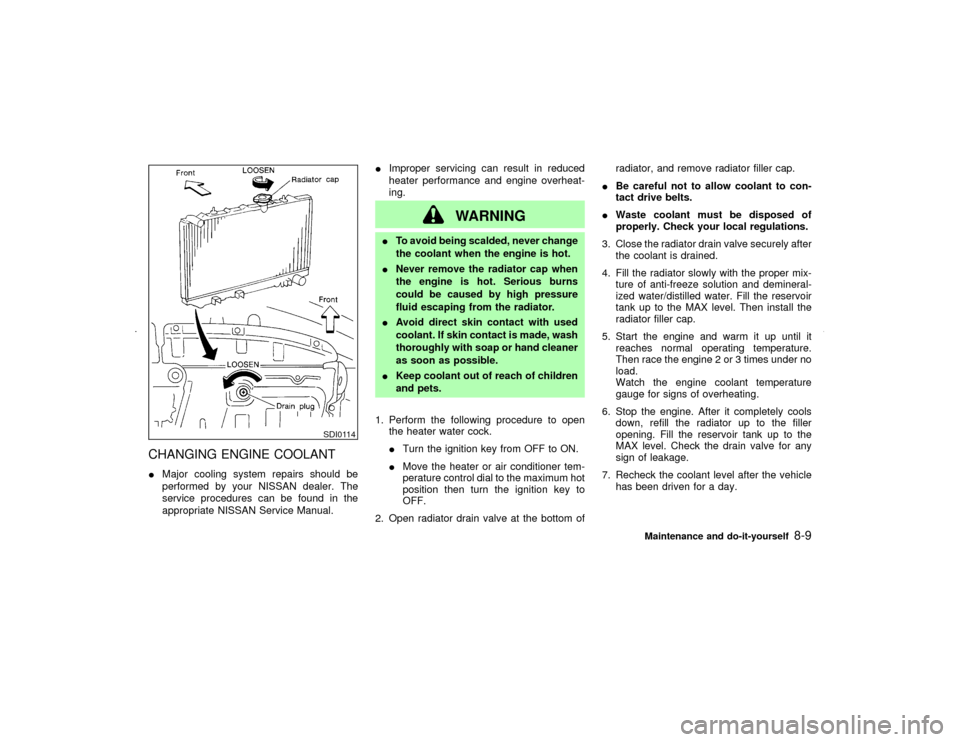
CHANGING ENGINE COOLANTIMajor cooling system repairs should be
performed by your NISSAN dealer. The
service procedures can be found in the
appropriate NISSAN Service Manual.IImproper servicing can result in reduced
heater performance and engine overheat-
ing.
WARNING
ITo avoid being scalded, never change
the coolant when the engine is hot.
INever remove the radiator cap when
the engine is hot. Serious burns
could be caused by high pressure
fluid escaping from the radiator.
IAvoid direct skin contact with used
coolant. If skin contact is made, wash
thoroughly with soap or hand cleaner
as soon as possible.
IKeep coolant out of reach of children
and pets.
1. Perform the following procedure to open
the heater water cock.
ITurn the ignition key from OFF to ON.
IMove the heater or air conditioner tem-
perature control dial to the maximum hot
position then turn the ignition key to
OFF.
2. Open radiator drain valve at the bottom ofradiator, and remove radiator filler cap.
IBe careful not to allow coolant to con-
tact drive belts.
IWaste coolant must be disposed of
properly. Check your local regulations.
3. Close the radiator drain valve securely after
the coolant is drained.
4. Fill the radiator slowly with the proper mix-
ture of anti-freeze solution and demineral-
ized water/distilled water. Fill the reservoir
tank up to the MAX level. Then install the
radiator filler cap.
5. Start the engine and warm it up until it
reaches normal operating temperature.
Then race the engine 2 or 3 times under no
load.
Watch the engine coolant temperature
gauge for signs of overheating.
6. Stop the engine. After it completely cools
down, refill the radiator up to the filler
opening. Fill the reservoir tank up to the
MAX level. Check the drain valve for any
sign of leakage.
7. Recheck the coolant level after the vehicle
has been driven for a day.
SDI0114
Maintenance and do-it-yourself
8-9
Z
01.9.21/A33-D/V5.0
X
Page 233 of 247

trailer is hitched. Do not drive the vehicle if
it has an abnormal nose-up or nose-down
condition; check for improper tongue load,
overload, worn suspension or other pos-
sible causes of either condition.
IAlways secure items in the trailer to prevent
load shifts while driving.
IBe certain your rear view mirrors conform to
all federal, state or local regulations. If not,
install any mirrors required for towing be-
fore driving the vehicle.
Trailer towing tipsIn order to gain skill and an understanding of
the vehicle's behavior, you should practice
turning, stopping and backing up in an area
which is free from traffic. Steering stability, and
braking performance will be somewhat differ-
ent than under normal driving conditions.
IAlways secure items in the trailer to prevent
load shift while driving.
IAvoid abrupt starts, acceleration or stops.
IAvoid sharp turns or lane changes.
IAlways drive your vehicle at a moderate
speed.
IAlways block the wheels on both vehicle
and trailer when parking. Parking on aslope is not recommended; however, if you
must do so, and if your vehicle is equipped
with automatic transmission, first block the
wheels and apply the parking brake, and
then move the transmission selector lever
into the P (Park) position. If you move the
selector lever to the P (Park) position be-
fore blocking the wheels and applying the
parking brake, transmission damage could
occur.
IWhen going down a hill, shift into a lower
gear and use the engine braking effect.
When ascending a long grade, downshift
the transmission to a lower gear and reduce
speed to reduce chances of engine over-
loading and/or overheating.
IIf the engine coolant rises to an extremely
high temperature when the air conditioning
system is on, turn off the air conditioner.
Coolant heat can be additionally vented by
opening the windows, switching the fan
control to high and setting the temperature
control to the HOT position.
ITrailer towing requires more fuel than nor-
mal circumstances.
IAvoid towing a trailer for the first 500 miles
(800 km).
IHave your vehicle serviced more often thanat intervals specified in the recommended
maintenance schedule.
IWhen making a turn, your trailer wheels will
be closer to the inside of the turn than your
vehicle wheels. To compensate for this,
make a larger than normal turning radius
during the turn.
ICrosswinds and rough roads will adversely
affect vehicle/trailer handling, possibly
causing vehicle sway. When being passed
by larger vehicles, be prepared for possible
changes in crosswinds that could affect
vehicle handling. If swaying does occur,
firmly grip the steering wheel, steer straight
ahead, and immediately (but gradually) re-
duce vehicle speed. This combination will
help stabilize the vehicle. Never increase
speed.
IBe careful when passing other vehicles.
Passing while towing a trailer requires con-
siderably more distance than normal pass-
ing. Remember the length of the trailer
must also pass the other vehicle before you
can safely change lanes.
ITo maintain engine braking efficiency and
electrical charging performance, do not use
fifth gear (manual transmission) or over-
drive (automatic transmission).9-18
Technical and consumer information
Z
01.9.21/A33-D/V5.0
X
Page 236 of 247
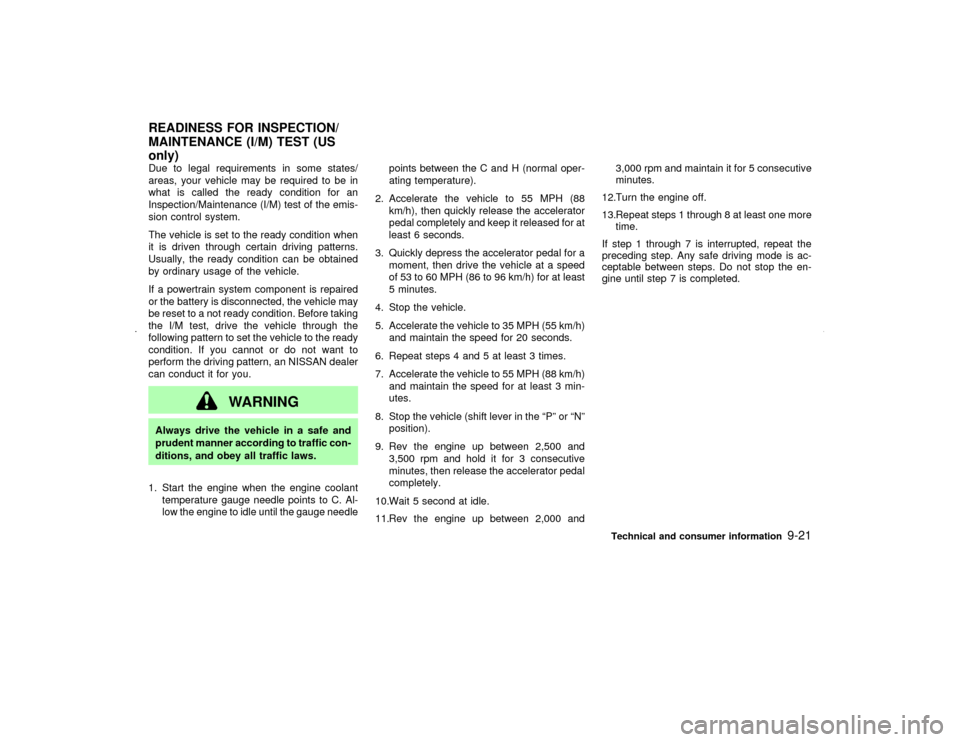
Due to legal requirements in some states/
areas, your vehicle may be required to be in
what is called the ready condition for an
Inspection/Maintenance (I/M) test of the emis-
sion control system.
The vehicle is set to the ready condition when
it is driven through certain driving patterns.
Usually, the ready condition can be obtained
by ordinary usage of the vehicle.
If a powertrain system component is repaired
or the battery is disconnected, the vehicle may
be reset to a not ready condition. Before taking
the I/M test, drive the vehicle through the
following pattern to set the vehicle to the ready
condition. If you cannot or do not want to
perform the driving pattern, an NISSAN dealer
can conduct it for you.
WARNING
Always drive the vehicle in a safe and
prudent manner according to traffic con-
ditions, and obey all traffic laws.
1. Start the engine when the engine coolant
temperature gauge needle points to C. Al-
low the engine to idle until the gauge needlepoints between the C and H (normal oper-
ating temperature).
2. Accelerate the vehicle to 55 MPH (88
km/h), then quickly release the accelerator
pedal completely and keep it released for at
least 6 seconds.
3. Quickly depress the accelerator pedal for a
moment, then drive the vehicle at a speed
of 53 to 60 MPH (86 to 96 km/h) for at least
5 minutes.
4. Stop the vehicle.
5. Accelerate the vehicle to 35 MPH (55 km/h)
and maintain the speed for 20 seconds.
6. Repeat steps 4 and 5 at least 3 times.
7. Accelerate the vehicle to 55 MPH (88 km/h)
and maintain the speed for at least 3 min-
utes.
8. Stop the vehicle (shift lever in the ªPº or ªNº
position).
9. Rev the engine up between 2,500 and
3,500 rpm and hold it for 3 consecutive
minutes, then release the accelerator pedal
completely.
10.Wait 5 second at idle.
11.Rev the engine up between 2,000 and3,000 rpm and maintain it for 5 consecutive
minutes.
12.Turn the engine off.
13.Repeat steps 1 through 8 at least one more
time.
If step 1 through 7 is interrupted, repeat the
preceding step. Any safe driving mode is ac-
ceptable between steps. Do not stop the en-
gine until step 7 is completed.READINESS FOR INSPECTION/
MAINTENANCE (I/M) TEST (US
only)
Technical and consumer information
9-21
Z
01.9.21/A33-D/V5.0
X
Page 241 of 247

Cleaning exterior and interior .................... 7-2, 7-4
Clock ............................................................... 2-30
Clutch
Clutch pedal .............................................. 8-22
Fluid ........................................................... 8-14
Cold weather driving ....................................... 5-20
Compact spare tire ......................................... 8-37
Console box .................................................... 2-26
Controls
Heater and air conditioner controls ............. 4-3
Heater and semiautomatic air
conditioner ................................................... 4-3
Coolant
Capacities and recommended fuel/
lubricants ..................................................... 9-2
Changing engine coolant ............................ 8-9
Checking engine coolant level .................... 8-8
Corrosion protection ......................................... 7-5
Cruise control.................................................. 5-13
Cup holder ...................................................... 2-24
D
Daytime running light system ......................... 2-18
Defogger switch, Rear window and outside mirror
defogger switch............................................... 2-15
Dimensions and weights ................................... 9-9
Door open warning light ................................... 2-8
Drive belts ....................................................... 8-17
Drive positioner, Automatic ............................. 3-16
Driving
Cold weather driving ................................. 5-20
Driving with automatic transmission .... 5-4, 5-8
Driving with manual transmission ...... 5-5, 5-11Precautions when starting and driving ........ 5-2
E
Economy, Fuel ................................................ 5-15
Emission control information label .................. 9-11
Emission control system warranty .................. 9-20
Engine
Before starting the engine ........................... 5-7
Block heater .............................................. 5-21
Capacities and recommended fuel/
lubricants ..................................................... 9-2
Changing engine coolant ............................ 8-9
Changing engine oil .................................. 8-11
Changing engine oil filter .......................... 8-12
Checking engine coolant level .................... 8-8
Checking engine oil level .......................... 8-10
Coolant temperature gauge ........................ 2-5
Engine compartment check locations ......... 8-7
Engine cooling system ................................ 8-8
Engine oil................................................... 8-10
Engine oil and oil filter recommendation..... 9-5
Engine oil viscosity ...................................... 9-5
Engine serial number ................................ 9-11
Engine specifications................................... 9-7
If your vehicle overheats ............................. 6-9
Starting the engine ...................................... 5-7
Exhaust gas (Carbon monoxide) ...................... 5-2
F
F.M.V.S.S. certification label........................... 9-11
Filter, Air cleaner housing filter ....................... 8-18Flashers (See hazard warning flasher
switch) ............................................................. 2-19
Flat tire .............................................................. 6-2
Floor mat cleaning ............................................ 7-4
Fluid
Automatic transmission fluid (ATF) ........... 8-12
Brake and clutch fluid................................ 8-14
Capacities and recommended fuel/
lubricants ..................................................... 9-2
Engine coolant............................................. 8-8
Engine oil................................................... 8-10
Power steering fluid................................... 8-14
Window washer fluid ................................. 8-15
Fog light switch ............................................... 2-19
Folding rear seat............................................... 1-5
Front air bag system (See supplemental restraint
system) ........................................................... 1-13
Front power seat adjustment ............................ 1-3
Fuel
Capacities and recommended fuel/
lubricants ..................................................... 9-2
filler cap ..................................................... 3-12
filler lid ....................................................... 3-12
Fuel economy ............................................ 5-15
Fuel octane rating ....................................... 9-3
Fuel recommendation.................................. 9-3
Gauge .......................................................... 2-5
Fuses .............................................................. 8-22
Fusible links .................................................... 8-23
G
Gas cap .......................................................... 3-12
Gauge ............................................................... 2-3
Z
01.9.21/A33-D/V5.0
X
10-2
Page 242 of 247
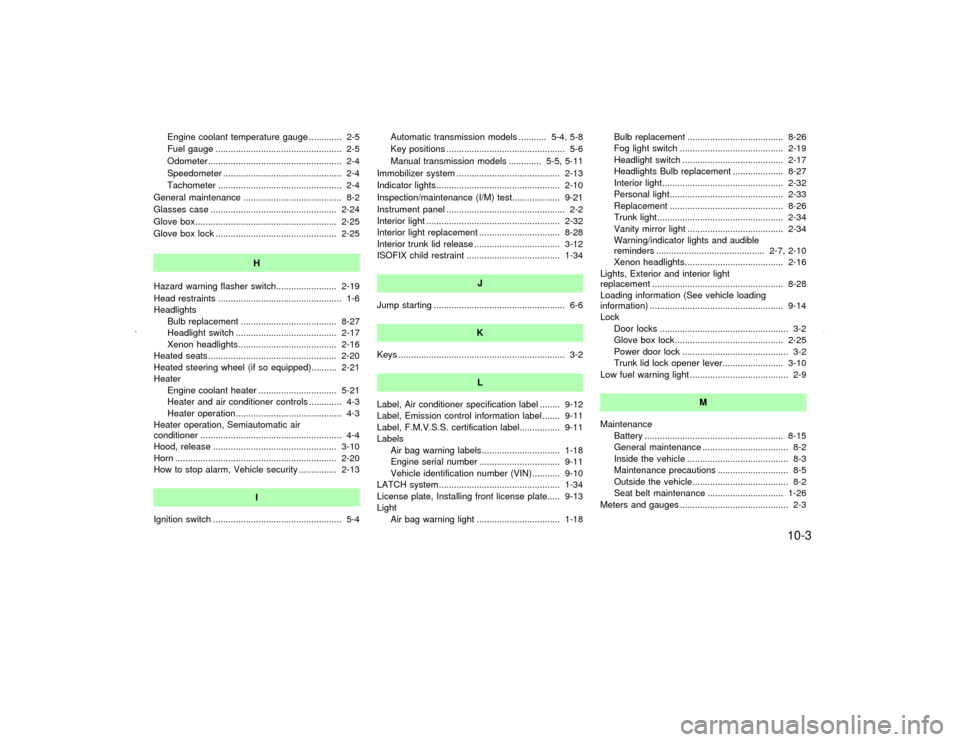
Engine coolant temperature gauge ............. 2-5
Fuel gauge .................................................. 2-5
Odometer..................................................... 2-4
Speedometer ............................................... 2-4
Tachometer ................................................. 2-4
General maintenance ....................................... 8-2
Glasses case .................................................. 2-24
Glove box........................................................ 2-25
Glove box lock ................................................ 2-25
H
Hazard warning flasher switch........................ 2-19
Head restraints ................................................. 1-6
Headlights
Bulb replacement ...................................... 8-27
Headlight switch ........................................ 2-17
Xenon headlights....................................... 2-16
Heated seats................................................... 2-20
Heated steering wheel (if so equipped).......... 2-21
Heater
Engine coolant heater ............................... 5-21
Heater and air conditioner controls ............. 4-3
Heater operation.......................................... 4-3
Heater operation, Semiautomatic air
conditioner ........................................................ 4-4
Hood, release ................................................. 3-10
Horn ................................................................ 2-20
How to stop alarm, Vehicle security ............... 2-13
I
Ignition switch ................................................... 5-4Automatic transmission models ........... 5-4, 5-8
Key positions ............................................... 5-6
Manual transmission models ............. 5-5, 5-11
Immobilizer system ......................................... 2-13
Indicator lights................................................. 2-10
Inspection/maintenance (I/M) test................... 9-21
Instrument panel ............................................... 2-2
Interior light ..................................................... 2-32
Interior light replacement ................................ 8-28
Interior trunk lid release .................................. 3-12
ISOFIX child restraint ..................................... 1-34
J
Jump starting .................................................... 6-6
K
Keys .................................................................. 3-2
L
Label, Air conditioner specification label ........ 9-12
Label, Emission control information label ....... 9-11
Label, F.M.V.S.S. certification label................ 9-11
Labels
Air bag warning labels............................... 1-18
Engine serial number ................................ 9-11
Vehicle identification number (VIN)........... 9-10
LATCH system................................................ 1-34
License plate, Installing front license plate..... 9-13
Light
Air bag warning light ................................. 1-18Bulb replacement ...................................... 8-26
Fog light switch ......................................... 2-19
Headlight switch ........................................ 2-17
Headlights Bulb replacement .................... 8-27
Interior light................................................ 2-32
Personal light............................................. 2-33
Replacement ............................................. 8-26
Trunk light.................................................. 2-34
Vanity mirror light ...................................... 2-34
Warning/indicator lights and audible
reminders ........................................... 2-7, 2-10
Xenon headlights....................................... 2-16
Lights, Exterior and interior light
replacement .................................................... 8-28
Loading information (See vehicle loading
information) ..................................................... 9-14
Lock
Door locks ................................................... 3-2
Glove box lock........................................... 2-25
Power door lock .......................................... 3-2
Trunk lid lock opener lever........................ 3-10
Low fuel warning light ....................................... 2-9
M
Maintenance
Battery ....................................................... 8-15
General maintenance .................................. 8-2
Inside the vehicle ........................................ 8-3
Maintenance precautions ............................ 8-5
Outside the vehicle...................................... 8-2
Seat belt maintenance .............................. 1-26
Meters and gauges ........................................... 2-3
Z
01.9.21/A33-D/V5.0
X
10-3
Page 244 of 247
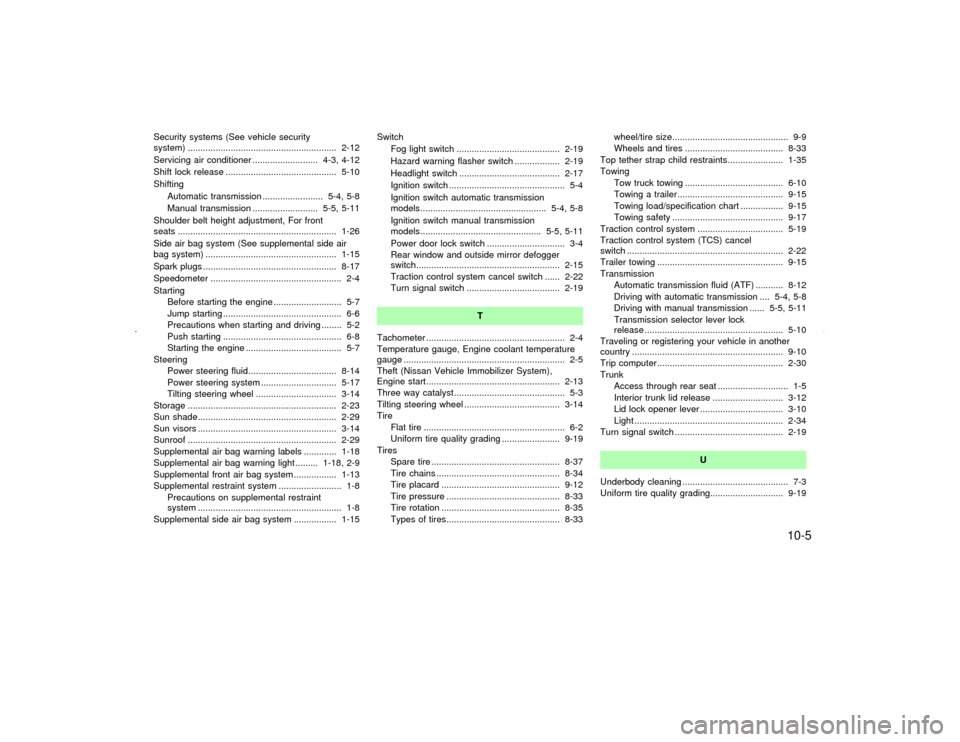
Security systems (See vehicle security
system) ........................................................... 2-12
Servicing air conditioner .......................... 4-3, 4-12
Shift lock release ............................................ 5-10
Shifting
Automatic transmission ........................ 5-4, 5-8
Manual transmission .......................... 5-5, 5-11
Shoulder belt height adjustment, For front
seats ............................................................... 1-26
Side air bag system (See supplemental side air
bag system) .................................................... 1-15
Spark plugs ..................................................... 8-17
Speedometer .................................................... 2-4
Starting
Before starting the engine ........................... 5-7
Jump starting ............................................... 6-6
Precautions when starting and driving ........ 5-2
Push starting ............................................... 6-8
Starting the engine ...................................... 5-7
Steering
Power steering fluid................................... 8-14
Power steering system .............................. 5-17
Tilting steering wheel ................................ 3-14
Storage ........................................................... 2-23
Sun shade....................................................... 2-29
Sun visors ....................................................... 3-14
Sunroof ........................................................... 2-29
Supplemental air bag warning labels ............. 1-18
Supplemental air bag warning light ......... 1-18, 2-9
Supplemental front air bag system ................. 1-13
Supplemental restraint system ......................... 1-8
Precautions on supplemental restraint
system ......................................................... 1-8
Supplemental side air bag system ................. 1-15Switch
Fog light switch ......................................... 2-19
Hazard warning flasher switch .................. 2-19
Headlight switch ........................................ 2-17
Ignition switch .............................................. 5-4
Ignition switch automatic transmission
models.................................................. 5-4, 5-8
Ignition switch manual transmission
models................................................ 5-5, 5-11
Power door lock switch ............................... 3-4
Rear window and outside mirror defogger
switch......................................................... 2-15
Traction control system cancel switch ...... 2-22
Turn signal switch ..................................... 2-19
T
Tachometer ....................................................... 2-4
Temperature gauge, Engine coolant temperature
gauge ................................................................ 2-5
Theft (Nissan Vehicle Immobilizer System),
Engine start..................................................... 2-13
Three way catalyst ............................................ 5-3
Tilting steering wheel ...................................... 3-14
Tire
Flat tire ........................................................ 6-2
Uniform tire quality grading ....................... 9-19
Tires
Spare tire ................................................... 8-37
Tire chains ................................................. 8-34
Tire placard ............................................... 9-12
Tire pressure ............................................. 8-33
Tire rotation ............................................... 8-35
Types of tires............................................. 8-33wheel/tire size.............................................. 9-9
Wheels and tires ....................................... 8-33
Top tether strap child restraints ...................... 1-35
Towing
Tow truck towing ....................................... 6-10
Towing a trailer.......................................... 9-15
Towing load/specification chart ................. 9-15
Towing safety ............................................ 9-17
Traction control system .................................. 5-19
Traction control system (TCS) cancel
switch .............................................................. 2-22
Trailer towing .................................................. 9-15
Transmission
Automatic transmission fluid (ATF) ........... 8-12
Driving with automatic transmission .... 5-4, 5-8
Driving with manual transmission ...... 5-5, 5-11
Transmission selector lever lock
release ....................................................... 5-10
Traveling or registering your vehicle in another
country ............................................................ 9-10
Trip computer.................................................. 2-30
Trunk
Access through rear seat ............................ 1-5
Interior trunk lid release ............................ 3-12
Lid lock opener lever ................................. 3-10
Light ........................................................... 2-34
Turn signal switch ........................................... 2-19
U
Underbody cleaning .......................................... 7-3
Uniform tire quality grading............................. 9-19
Z
01.9.21/A33-D/V5.0
X
10-5